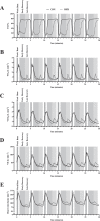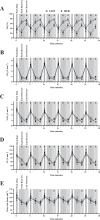Acute physiological responses of blood flow restriction between high-intensity interval repetitions in trained cyclists
- PMID: 38874956
- PMCID: PMC11235839
- DOI: 10.1002/ejsc.12107
Acute physiological responses of blood flow restriction between high-intensity interval repetitions in trained cyclists
Abstract
Blood flow restriction (BFR) is increasingly being used to enhance aerobic performance in endurance athletes. This study examined physiological responses to BFR applied in recovery phases within a high-intensity interval training (HIIT) session in trained cyclists. Eleven competitive road cyclists (mean ± SD, age: 28 ± 7 years, body mass: 69 ± 6 kg, peak oxygen uptake: 65 ± 9 mL · kg-1 · min-1) completed two randomised crossover conditions: HIIT with (BFR) and without (CON) BFR applied during recovery phases. HIIT consisted of six 30-s cycling bouts at an intensity equivalent to 85% of maximal 30-s power (523 ± 93 W), interspersed with 4.5-min recovery. BFR (200 mmHg, 12 cm cuff width) was applied for 2-min in the early recovery phase between each interval. Pulmonary gas exchange (V̇O2, V̇CO2, and V̇E), tissue oxygen saturation index (TSI), heart rate (HR), and serum vascular endothelial growth factor concentration (VEGF) were measured. Compared to CON, BFR increased V̇CO2 and V̇E during work bouts (both p < 0.05, dz < 0.5), but there was no effect on V̇O2, TSI, or HR (p > 0.05). In early recovery, BFR decreased TSI, V̇O2, V̇CO2, and V̇E (all p < 0.05, dz > 0.8) versus CON, with no change in HR (p > 0.05). In late recovery, when BFR was released, V̇O2, V̇CO2, V̇E, and HR increased, but TSI decreased versus CON (all p < 0.05, dz > 0.8). There was a greater increase in VEGF at 3-h post-exercise in BFR compared to CON (p < 0.05, dz > 0.8). Incorporating BFR into HIIT recovery phases altered physiological responses compared to exercise alone.
Keywords: cardiorespiratory; physiology; recovery; stress; training.
© 2024 The Authors. European Journal of Sport Science published by Wiley‐VCH GmbH on behalf of European College of Sport Science.
Conflict of interest statement
The authors declare no potential conflict of interest.
Figures



Similar articles
-
High-intensity interval training with blood-flow restriction enhances sprint and maximal aerobic power in male endurance athletes.Appl Physiol Nutr Metab. 2025 Jan 1;50:1-11. doi: 10.1139/apnm-2024-0378. Appl Physiol Nutr Metab. 2025. PMID: 39642351 Clinical Trial.
-
The combined effect of sprint interval training and postexercise blood flow restriction on critical power, capillary growth, and mitochondrial proteins in trained cyclists.J Appl Physiol (1985). 2019 Jan 1;126(1):51-59. doi: 10.1152/japplphysiol.01082.2017. Epub 2018 Oct 18. J Appl Physiol (1985). 2019. PMID: 30335575
-
Acute Effects of Running and Blood Flow Restriction on Gas Exchange and Perceptual Responses.J Strength Cond Res. 2025 Mar 1;39(3):e436-e443. doi: 10.1519/JSC.0000000000004994. J Strength Cond Res. 2025. PMID: 39977024 Clinical Trial.
-
Effects of High-Intensity Interval Training in Combat Sports: A Systematic Review with Meta-Analysis.J Strength Cond Res. 2020 Mar;34(3):888-900. doi: 10.1519/JSC.0000000000003255. J Strength Cond Res. 2020. PMID: 31904713
-
Acute and Chronic Effects of Blood Flow Restricted High-Intensity Interval Training: A Systematic Review.Sports Med Open. 2022 Sep 30;8(1):122. doi: 10.1186/s40798-022-00506-y. Sports Med Open. 2022. PMID: 36178530 Free PMC article.
Cited by
-
Heart Rate and Oxygen Uptake During Recovery from High-Intensity Interval Training: A Retrospective Analysis.Int J Environ Res Public Health. 2025 Jun 25;22(7):999. doi: 10.3390/ijerph22070999. Int J Environ Res Public Health. 2025. PMID: 40724066 Free PMC article.
References
-
- Cantó, Carles , Jiang Lake Q., Deshmukh Atul S., Mataki Chikage, Coste Agnes, Lagouge Marie, Zierath Juleen R., and Auwerx Johan. 2010. “Interdependence of AMPK and SIRT1 for Metabolic Adaptation to Fasting and Exercise in Skeletal Muscle.” Cell Metabolism 11(3): 213–219. 10.1016/j.cmet.2010.02.006. - DOI - PMC - PubMed
-
- Chinsomboon, Jessica , Ruas Jorge, Gupta Rana K., Thom Robyn, Shoag Jonathan, Rowe Glenn C., Sawada Naoki, Raghuram Srilatha, and Arany Zoltan. 2009. “The Transcriptional Coactivator PGC‐1α Mediates Exercise‐Induced Angiogenesis in Skeletal Muscle.” Proceedings of the National Academy of Sciences 106(50): 21401–21406. 10.1073/pnas.0909131106. - DOI - PMC - PubMed
-
- Christiansen, Danny , Murphy Robyn M., Bangsbo Jens, Stathis Christos G., and Bishop David J.. 2018. “Increased FXYD1 and PGC‐1α mRNA after Blood Flow‐restricted Running Is Related to Fibre Type‐specific AMPK Signalling and Oxidative Stress in Human Muscle.” Acta Physiologica 223(2): e13045. 10.1111/apha.13045. - DOI - PMC - PubMed
Publication types
MeSH terms
Substances
LinkOut - more resources
Full Text Sources
Miscellaneous

